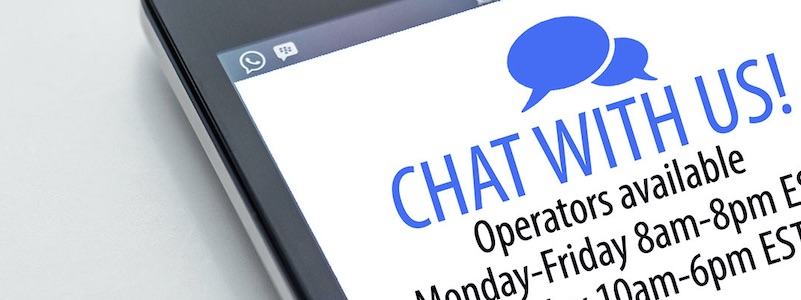
Shoppers increasingly prefer live chat for sales and support queries. But live chat requires staffing, which is often beyond the reach of small businesses. Automated chatbots can help.
Live chat is a proven way to close online sales and provide post-order support. Shoppers are frustrated over telephone wait times, phone-tree menus, and outsourced support. Online chat can provide quick answers about products, shipping costs, order statuses, and general support queries.
For smaller businesses, though, live chat has a few obstacles that can prevent its implementation. Live chat software, whether installed on the local server or accessed via a third-party plugin, isn’t always affordable. Aside from monthly and per-session service costs, it often requires additional staffing. Providing support during prime time hours means at least one additional work shift for agents, who are paid whether or not they’re answering requests.
Live chat has other downsides. Response time is dependent on the total number of requests and available agents. Similar to website load times, a delay in response increases the risk of the visitor leaving.
According to LiveChat, a provider, the smallest online retailers in the United States handle fewer chats per day, but initial response and resolution times are longer than the global average. LiveChat found that U.S.-based B2C retailers with fewer than 10 employees had a longer wait time than that global average — 1 minute 21 seconds versus 49 seconds for the global average.
Chatbots via Facebook Messenger
Chatbots can help bridge the gap between live chat and self-help support pages. While highly customized automatic chatbots require a large financial investment, there are many affordable ways to integrate more personal conversations. Facebook Messenger ranks near the top of the list for both small and large businesses.
Here’s why.
Nearly 70 percent of Americans use Facebook. With more than 1.3 billion users, Messenger is one of the most popular messaging apps that allow for open development. Big players such as Lego, Spotify, Fandango, and Sephora use Messenger chatbots to interact with visitors and guide them to purchase pages.
Lego’s gift bot, Ralph, is a good example of how using conditionals to guide shoppers to specific products can increase sales. Available via Messenger, Ralph asks multiple-choice questions to determine a child’s age group and interests. In the end, users are presented with a group of products that fit their responses.
Setting up automatic conversations via Messenger is fairly simple. Several services tie into the process. Many are freemium — allowing for elementary conversations for free, but requiring nominal fees for complicated setups.
Messenger chatbots have plenty of advantages, including:
- Widespread accessibility. Since so many shoppers already use it, the Messenger app is a familiar platform.
- Integration with the website. Want to offer chats directly on a product page? Install Facebook’s Customer Chat Plugin.
- Desktop support. When shoppers initiate a conversation from the Facebook website, the chat happens within Facebook. When activated elsewhere, Messenger.com is launched, presenting an experience similar to the smartphone app.
- Modern media support. Messenger supports link previews, animated GIFs, videos, emojis, and more. Thus the chatbot can speak to the target audience using your company’s branding and voice.
- Live agent support. Chatbots are helpful for handling common requests, but not all requests. When there’s something the bot can’t address, users can request a person.
- Lead generation and list segmenting. Since Facebook already has connectivity with those who chat via Messenger, merchants don’t have to collect users’ names or require a signup to start a chat. Once they’ve chatted, users can opt into receiving broadcast messages, such as discounts and new product announcements.
- Automatic invites. It’s possible to configure chatbots to send messages based on someone’s interaction with specific Facebook posts. For example, you could create a post that encourages people to respond with their favorite color and configure the chatbot to send a personalized message as a result.
- Sell through Messenger. Depending on the tools used to create and manage the chatbot, you can sell products and collect funds directly via Messenger.
- Sharing capabilities. Bots can be customized to allow the user to share results and content in other message threads.
There are many other features. And Facebook is continually improving Messenger. What we see today is the beginning stage. It’s enough, though, to make businesses want to incorporate chatbots as part of the customer service plan.
As with anything, there are disadvantages to using Messenger. It doesn’t have a 100 percent reach because some people don’t use Facebook. You’re also restricted to what Facebook allows. Hence Messenger, and any chatbot, should never replace existing support channels.
Beyond Messenger
Before implementing, research all providers, not just Messenger. Then outline your game plan.
It’s possible to develop your own Messenger chatbot. But unless you want to maintain the coding updates, it’s probably best to use a SaaS provider. Compare various offerings and set up trial accounts to test the features and reliability. Consider a secondary Facebook page wherein your staff and friends can experiment.
After learning how the chatbot works, outline the prompts and responses. This will help in the configuration process. Define your conditionals: what happens if users choose one selection over another.
Once launched, analyze user activity and conversations. This helps to pinpoint problems and create content to sell and support other shoppers.